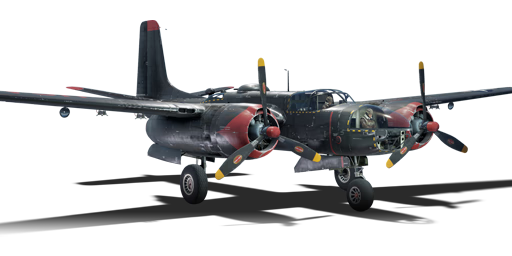


The A-26C-45DT is a premium gift American bomber. It has been in the game since the start of the Open Beta Test prior to Update 1.27. It is exclusively available on Playstation and can be obtained by purchasing a special pack.
With speed, manoeuvrability and large hitting power, the A-26 should not be taken lightly. Although players may find the battle rating too high, this isn't the case- in fact, it may be about right. The plane has a cruise speed which all the piston engine bombers dream of and is currently unmatched in the game. Reaching a maximum speed of 568.8 km/h the Invader is faster than the comparable Tu-2 by a significant 202 km/h. This speed allows the A-26 to strike targets deep in enemy territory and early on better than any other aircraft (excluding the jet aircraft). It also has a 4,000 lb payload with a variety of load-out options, making it very versatile in its role, allowing it to attack many different targets with great efficiency. To add to this, it has 8 x Browning M2 .50 cal machine guns to attack soft targets and the unfortunate jet if you have the chance. Unlike the Mosquito, the A-26 has defensive gunner turrets and decent ones at that. With two twin M2 machine gun remote turrets it allows for the very accurate and deadly fire.
flaps
flaps
flaps
brake
| Belt | Belt filling | Armor penetration (mm) at a distance: | |||||
|---|---|---|---|---|---|---|---|
| 10 m | 100 m | 500 m | 1000 m | 1500 m | 2000 m | ||
| API-T/AP/AP/I | 30 | 27 | 20 | 13 | 9 | 6 | |
| AP-I/AP-I/API-T/I/I | 28 | 26 | 18 | 11 | 7 | 4 | |
| API-T/I/AP/AP/AP-I/AP-I | 30 | 27 | 20 | 13 | 9 | 6 | |
| API-T | 28 | 26 | 18 | 11 | 7 | 4 | |
| AP-I/I/AP-I/I | 28 | 26 | 18 | 11 | 7 | 4 | |
| Belt | Belt filling | Armor penetration (mm) at a distance: | |||||
|---|---|---|---|---|---|---|---|
| 10 m | 100 m | 500 m | 1000 m | 1500 m | 2000 m | ||
| API-T/AP/AP/I | 30 | 27 | 20 | 13 | 9 | 6 | |
| AP/AP/AP/API-T | 30 | 27 | 20 | 13 | 9 | 6 | |
| AP-I/I/AP-I/API-T | 28 | 26 | 18 | 11 | 7 | 4 | |







 2 x (110 / 225 / 500) %
2 x (110 / 225 / 500) % 
 2 x 166 %
2 x 166 % 

Flight performance | |
|---|---|
Survivability |
|---|
Weaponry | |
|---|---|